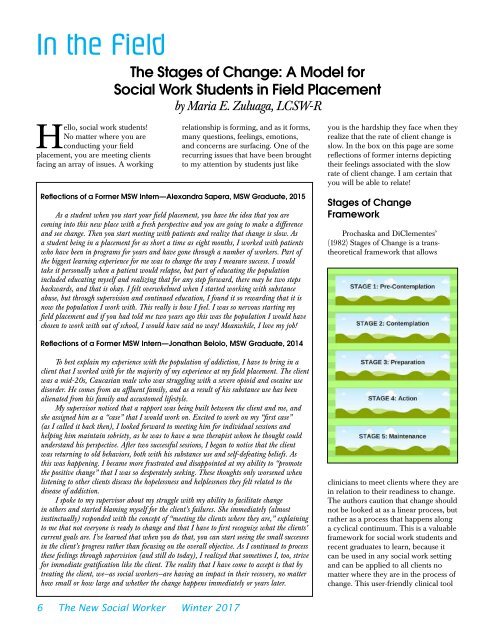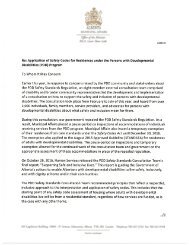In This Issue
click
click
Create successful ePaper yourself
Turn your PDF publications into a flip-book with our unique Google optimized e-Paper software.
<strong>In</strong> the Field<br />
The Stages of Change: A Model for<br />
Social Work Students in Field Placement<br />
by Maria E. Zuluaga, LCSW-R<br />
Hello, social work students!<br />
No matter where you are<br />
conducting your field<br />
placement, you are meeting clients<br />
facing an array of issues. A working<br />
relationship is forming, and as it forms,<br />
many questions, feelings, emotions,<br />
and concerns are surfacing. One of the<br />
recurring issues that have been brought<br />
to my attention by students just like<br />
you is the hardship they face when they<br />
realize that the rate of client change is<br />
slow. <strong>In</strong> the box on this page are some<br />
reflections of former interns depicting<br />
their feelings associated with the slow<br />
rate of client change. I am certain that<br />
you will be able to relate!<br />
Reflections of a Former MSW <strong>In</strong>tern—Alexandra Sapera, MSW Graduate, 2015<br />
As a student when you start your field placement, you have the idea that you are<br />
coming into this new place with a fresh perspective and you are going to make a difference<br />
and see change. Then you start meeting with patients and realize that change is slow. As<br />
a student being in a placement for as short a time as eight months, I worked with patients<br />
who have been in programs for years and have gone through a number of workers. Part of<br />
the biggest learning experience for me was to change the way I measure success. I would<br />
take it personally when a patient would relapse, but part of educating the population<br />
included educating myself and realizing that for any step forward, there may be two steps<br />
backwards, and that is okay. I felt overwhelmed when I started working with substance<br />
abuse, but through supervision and continued education, I found it so rewarding that it is<br />
now the population I work with. <strong>This</strong> really is how I feel. I was so nervous starting my<br />
field placement and if you had told me two years ago this was the population I would have<br />
chosen to work with out of school, I would have said no way! Meanwhile, I love my job!<br />
Stages of Change<br />
Framework<br />
Prochaska and DiClementes’<br />
(1982) Stages of Change is a transtheoretical<br />
framework that allows<br />
Reflections of a Former MSW <strong>In</strong>tern—Jonathan Belolo, MSW Graduate, 2014<br />
To best explain my experience with the population of addiction, I have to bring in a<br />
client that I worked with for the majority of my experience at my field placement. The client<br />
was a mid-20s, Caucasian male who was struggling with a severe opioid and cocaine use<br />
disorder. He comes from an affluent family, and as a result of his substance use has been<br />
alienated from his family and accustomed lifestyle.<br />
My supervisor noticed that a rapport was being built between the client and me, and<br />
she assigned him as a “case” that I would work on. Excited to work on my “first case”<br />
(as I called it back then), I looked forward to meeting him for individual sessions and<br />
helping him maintain sobriety, as he was to have a new therapist whom he thought could<br />
understand his perspective. After two successful sessions, I began to notice that the client<br />
was returning to old behaviors, both with his substance use and self-defeating beliefs. As<br />
this was happening. I became more frustrated and disappointed at my ability to “promote<br />
the positive change” that I was so desperately seeking. These thoughts only worsened when<br />
listening to other clients discuss the hopelessness and helplessness they felt related to the<br />
disease of addiction.<br />
I spoke to my supervisor about my struggle with my ability to facilitate change<br />
in others and started blaming myself for the client’s failures. She immediately (almost<br />
instinctually) responded with the concept of “meeting the clients where they are,” explaining<br />
to me that not everyone is ready to change and that I have to first recognize what the clients’<br />
current goals are. I've learned that when you do that, you can start seeing the small successes<br />
in the client’s progress rather than focusing on the overall objective. As I continued to process<br />
these feelings through supervision (and still do today), I realized that sometimes I, too, strive<br />
for immediate gratification like the client. The reality that I have come to accept is that by<br />
treating the client, we—as social workers—are having an impact in their recovery, no matter<br />
how small or how large and whether the change happens immediately or years later.<br />
clinicians to meet clients where they are<br />
in relation to their readiness to change.<br />
The authors caution that change should<br />
not be looked at as a linear process, but<br />
rather as a process that happens along<br />
a cyclical continuum. <strong>This</strong> is a valuable<br />
framework for social work students and<br />
recent graduates to learn, because it<br />
can be used in any social work setting<br />
and can be applied to all clients no<br />
matter where they are in the process of<br />
change. <strong>This</strong> user-friendly clinical tool<br />
6 The New Social Worker Winter 2017




